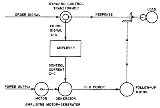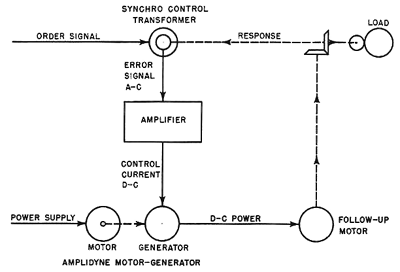
Amplidyne
Encyclopedia
An amplidyne is an electromechanical amplifier
invented during World War II
by Ernst Alexanderson
. It is usually an AC motor driving a DC generator with modifications to increase the power gain available. A small electrical signal can control the position of a large motor using this approach.
which uses regeneration to increase its gain
. Energy comes from the motor, and the power output is controlled by changing the field current of the generator. In a typical generator the load brushes are positioned perpendicular to the magnetic field flux. To convert a generator to an amplidyne you connect what would be the load brushes together and take the output from another set of brushes that are parallel with the field. The perpendicular brushes are now called the 'quadrature' brushes. This simple change can increase the gain by a factor of 10,000 or more.
Historically, amplidynes were one of the first amplifiers to generate very high power (tens of kilowatts), allowing precise feedback
control of heavy machinery. Vacuum tubes of reasonable size were unable to deliver enough power to control large motors, but vacuum tube circuits driving the input of an amplidyne could be used to boost small signals up to the power needed to drive large motors. Early (World War II
era) gun tracking and radar systems used this approach.
Amplidynes are now obsolete technology. Modern electronic devices for controlling power in the kilowatt range include MOSFET
and IGBT devices.
 In its simplest form, an amplidyne follow-up system consists of:
In its simplest form, an amplidyne follow-up system consists of:
Chapter 10 of the U.S. Navy manual Naval Ordnance and Gunnery, Volume 1 (1957) explains the operation of the amplidyne:
Specifically, the phase of the control transformer's output (in phase with the synchro power source, or opposite phase)
provided the polarity of the error signal. A phase-sensitive demodulator, with the synchro AC power as its reference, created the DC error signal of the required polarity.
, and antiairctaft artillery
radar such as SCR-584 in 1942.
Later used to control processes in steelworks
.
Used to remotely operate the control rod
s in early nuclear submarine designs (S3G Triton).
Diesel-electric locomotive control systems.
Amplifier
Generally, an amplifier or simply amp, is a device for increasing the power of a signal.In popular use, the term usually describes an electronic amplifier, in which the input "signal" is usually a voltage or a current. In audio applications, amplifiers drive the loudspeakers used in PA systems to...
invented during World War II
World War II
World War II, or the Second World War , was a global conflict lasting from 1939 to 1945, involving most of the world's nations—including all of the great powers—eventually forming two opposing military alliances: the Allies and the Axis...
by Ernst Alexanderson
Ernst Alexanderson
Ernst Frederick Werner Alexanderson was a Swedish-American electrical engineer, who was a pioneer in radio and television development.-Background:...
. It is usually an AC motor driving a DC generator with modifications to increase the power gain available. A small electrical signal can control the position of a large motor using this approach.
How an amplidyne works
An amplidyne is a special type of motor-generatorMotor-generator
A motor-generator is a device for converting electrical power to another form. Motor-generator sets are used to convert frequency, voltage, or phase of power. They may also be used to isolate electrical loads from the electrical power supply line...
which uses regeneration to increase its gain
Gain
In electronics, gain is a measure of the ability of a circuit to increase the power or amplitude of a signal from the input to the output. It is usually defined as the mean ratio of the signal output of a system to the signal input of the same system. It may also be defined on a logarithmic scale,...
. Energy comes from the motor, and the power output is controlled by changing the field current of the generator. In a typical generator the load brushes are positioned perpendicular to the magnetic field flux. To convert a generator to an amplidyne you connect what would be the load brushes together and take the output from another set of brushes that are parallel with the field. The perpendicular brushes are now called the 'quadrature' brushes. This simple change can increase the gain by a factor of 10,000 or more.
Historically, amplidynes were one of the first amplifiers to generate very high power (tens of kilowatts), allowing precise feedback
Feedback
Feedback describes the situation when output from an event or phenomenon in the past will influence an occurrence or occurrences of the same Feedback describes the situation when output from (or information about the result of) an event or phenomenon in the past will influence an occurrence or...
control of heavy machinery. Vacuum tubes of reasonable size were unable to deliver enough power to control large motors, but vacuum tube circuits driving the input of an amplidyne could be used to boost small signals up to the power needed to drive large motors. Early (World War II
World War II
World War II, or the Second World War , was a global conflict lasting from 1939 to 1945, involving most of the world's nations—including all of the great powers—eventually forming two opposing military alliances: the Allies and the Axis...
era) gun tracking and radar systems used this approach.
Amplidynes are now obsolete technology. Modern electronic devices for controlling power in the kilowatt range include MOSFET
MOSFET
The metal–oxide–semiconductor field-effect transistor is a transistor used for amplifying or switching electronic signals. The basic principle of this kind of transistor was first patented by Julius Edgar Lilienfeld in 1925...
and IGBT devices.
How it is used in a gun mount

- a synchroSynchroA synchro is a type of rotary electrical transformer that is used for measuring the angle of a rotating machine such as an antenna platform. In its general physical construction, it is much like an electric motor...
control transformer; - an amplifierAmplifierGenerally, an amplifier or simply amp, is a device for increasing the power of a signal.In popular use, the term usually describes an electronic amplifier, in which the input "signal" is usually a voltage or a current. In audio applications, amplifiers drive the loudspeakers used in PA systems to...
; - the amplidyne motor-generator, which is similar to a Ward Leonard controlWard Leonard controlWard Leonard Control, also known as the Ward Leonard Drive System, was a widely used DC motor speed control system introduced by Harry Ward Leonard in 1891. In early 1900s, the control system of Ward Leonard was adopted by the U.S. Navy and also used in passenger lift of large mines...
drive; - and the follow-up DC motor which drives the load to be positioned.
Chapter 10 of the U.S. Navy manual Naval Ordnance and Gunnery, Volume 1 (1957) explains the operation of the amplidyne:
- "The synchro control transformer receives the order signal which indicates electrically what the position of the load should be. The rotor of the synchro control transformer is turned by the response shaft, which is geared to the load and so indicates what the position of the load actually is. The synchro compares the actual load position with the ordered position; and, if the two do not agree, it generates an alternating-current signal which is transmitted to the amplifier. The angular difference between the two positions is called the error, and the signal to the amplifier is the error signal. The error signal indicates by its electrical characteristics the size and direction of the error. If no error exists, the system is said to be in correspondence and the error signal is zero."
Specifically, the phase of the control transformer's output (in phase with the synchro power source, or opposite phase)
provided the polarity of the error signal. A phase-sensitive demodulator, with the synchro AC power as its reference, created the DC error signal of the required polarity.
Applications
Amplidynes were initially used for electric elevators, moving sidewalks (Paris 1900), to point naval gunsNaval artillery
Naval artillery, or naval riflery, is artillery mounted on a warship for use in naval warfare. Naval artillery has historically been used to engage either other ships, or targets on land; in the latter role it is currently termed naval gunfire fire support...
, and antiairctaft artillery
Artillery
Originally applied to any group of infantry primarily armed with projectile weapons, artillery has over time become limited in meaning to refer only to those engines of war that operate by projection of munitions far beyond the range of effect of personal weapons...
radar such as SCR-584 in 1942.
Later used to control processes in steelworks
Steel mill
A steel mill or steelworks is an industrial plant for the manufacture of steel.Steel is an alloy of iron and carbon. It is produced in a two-stage process. First, iron ore is reduced or smelted with coke and limestone in a blast furnace, producing molten iron which is either cast into pig iron or...
.
Used to remotely operate the control rod
Control rod
A control rod is a rod made of chemical elements capable of absorbing many neutrons without fissioning themselves. They are used in nuclear reactors to control the rate of fission of uranium and plutonium...
s in early nuclear submarine designs (S3G Triton).
Diesel-electric locomotive control systems.

